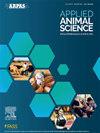Bacillus spp. supplementation stimulates the growth of preweaning bull calves offered milk replacer and pelleted starter supplement
IF 1.5
Q3 AGRICULTURE, DAIRY & ANIMAL SCIENCE
引用次数: 0
Abstract
Objective
In 2 experiments, the objective was to evaluate the effects of supplementing a Bacillus-based direct-fed microbial (DFM) on growth rates of preweaning dairy bull calves.
Materials and Methods
In experiment (Exp.) 1, 62 Holstein-Friesian bull calves were ranked by initial BW and assigned to (1) no DFM supplementation (n = 31; CON) or (2) supplementation of a Bacillus-based DFM in the milk replacer and pelleted feed (n = 31; DFM). Throughout the study, calves were housed individually, milk replacer was offered twice daily with equal amounts being offered twice daily following a programmed feeding. Starting on wk 3 of the study, pelleted feed was offered in controlled amounts to all calves, whereas corn silage and lucerne hay were offered ad libitum. In Exp. 2, 52 Holstein-Friesian bull calves were assigned to the same treatments as reported in Exp. 1 and maintained in group pens, with individual milk and solid feed intake recordings. All data were analyzed with the MIXED procedure of SAS (version 9.4), using calf as the experimental unit.
Results and Discussion
In Exp. 1, DFM-fed bull calves were heavier versus CON on d 42 and 63 of the study. A similar treatment × day interaction tended to be observed for ADG, so that ADG was greater in DFM from d 21 to 42 and tended to be greater from d 0 to 63. Similarly, in Exp. 2, calves fed DFM were heavier on d 56 (treatment × day interaction). For ADG, DFM-fed bull calves had a greater ADG from d 28 to 56 and 0 to 56. Daily pellet intake and G:F for calves fed milk replacer were greater for DFM-fed calves.
Implications and Applications
In summary, feeding a Bacillus-based DFM improved growth rates of low-risk, preweaning Holstein-Friesian bull calves, while also positively affecting milk and solid feed intake. These results indicate that bacterial-based DFM are a feasible strategy to promote the growth rate of calves offered milk replacer preparations.
乳代用品和颗粒状发酵剂均能促进断奶前公牛犊牛的生长
目的在2个试验中,研究添加芽孢杆菌直接饲喂微生物(DFM)对断奶前奶牛犊牛生长速率的影响。材料与方法在试验(Exp.) 1中,选取62头荷斯坦-弗里西亚公牛犊牛,按初始体重排序,分为(1)不添加DFM组(n = 31;CON)或(2)在代乳剂和颗粒饲料中添加芽孢杆菌基DFM (n = 31;DFM)。在整个研究过程中,小牛被单独饲养,每天两次提供等量的代用品,每天两次按照程序喂养。从研究的第3周开始,所有犊牛均按控制量饲喂颗粒饲料,而玉米青贮饲料和苜蓿干草则随意饲喂。在试验2中,52头荷斯坦-弗里西亚公牛犊牛被分配到与试验1相同的处理中,并在群栏中饲养,单独记录牛奶和固体饲料的摄取量。所有数据以小牛为实验单位,采用SAS (version 9.4)的MIXED程序进行分析。结果与讨论在实验1中,在研究的第42天和第63天,dfm喂养的公牛犊牛比CON更重。ADG也存在类似的处理×日交互作用,即在DFM中,ADG在第21 ~ 42天更大,在第0 ~ 63天更大。同样,在实验2中,犊牛在第56天(处理×日交互作用)时体重更重。在日增重方面,28 ~ 56天和0 ~ 56天dfm喂养的公牛日增重较大。犊牛日颗粒摄取量和G:F均高于代乳犊牛。综上所述,饲喂以芽状杆菌为基础的DFM提高了低风险、断奶前荷斯坦-弗里西亚公牛犊牛的生长速度,同时也对牛奶和固体饲料采食量产生了积极影响。由此可见,以细菌为基础的DFM是促进犊牛生长的一种可行策略。
本文章由计算机程序翻译,如有差异,请以英文原文为准。
求助全文
约1分钟内获得全文
求助全文

 求助内容:
求助内容: 应助结果提醒方式:
应助结果提醒方式:


